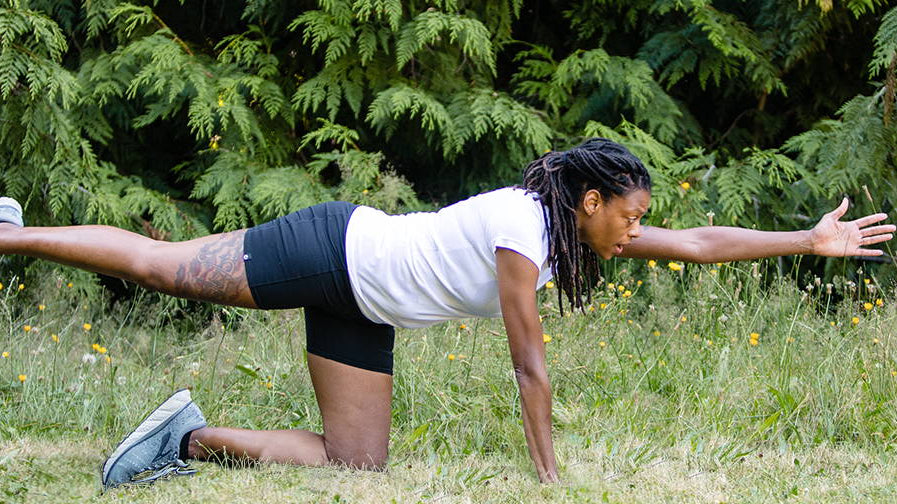Our chief bird, Sally Bergesen, had the pleasure of meeting Julie Morrill at Kara Goucher's Podium Retreat last fall. Julie began training in self-defense about twelve years ago in order to stay safe while running alone. Fierce training in hand-to-hand combat became her second favorite thing in the world to do (yes, running takes the cake).

Professionally, Julie is a consultant in emergency preparedness. She is also the cofounder of Mahila Partnership, a nonprofit addressing the most pressing unmet needs of women and girls following disasters. She teaches and trains in an Israeli-based system called Krav Maga, and especially loves teaching women and seeing them discover a power they never knew they had.
We're honored to have Julie share with us what she teaches runners across the globe - her top 5 tips to practicing safety while out on the roads.
As runners, we traverse the world. Most of the time, we have great experiences — seeing spectacular sunrises, catching a glimpse of a deer bounding through the woods, nodding a hello to the friendly man you see on the trail every morning. Sometimes, however, the experiences are not so good. For women in particular, sometimes our experiences can be downright scary. In this blog, I’ll provide you with guidance on how to keep yourself safe when running. The focus will be on threats of the human kind, but I’ll occasionally talk about the other threats out there, like cars, dogs, weather, and even bears.
As women runners, we’re often told “never run alone” and “always tell someone where you’ll be.” Yes, there is definitely strength in numbers, and it is always a good idea to tell someone where you plan to run. But if we’re being honest, we run alone a lot. And sometime we change up our running route on the fly. So what to do to stay safe? For starters:
- Be observant
- Be confident
- Trust your intuition
- Be “mean"
- Practice fighting
BE OBSERVANT
If I could recommend one thing that would help women stay safe it would be this: be observant. Being observant helps you recognize potentially dangerous situations early, so that you can avoid them or prepare for them.

Would you be observant enough to notice a potential threat?
A common behavior that is a big risk (sorry, you aren’t going to like it!) is running with headphones. Headphones are dangerous because they take away your ability to hear what’s around you and distract you from your surroundings. Yeah, I know, it’s really hard to stay motivated on a long run without music. If you absolutely can’t live without your headphones, at least keep the volume low and keep your eyes up and attuned to unexpected motion.
BE CONFIDENT
Have you ever watched one of those nature shows on PBS where the lions stalk gazelles? Isn’t it always the weak gazelles that become lion dinner? It only makes sense — the weak gazelles take less energy to catch and can’t fight back.
Pickpockets, muggers, and sexual predators are like lions: they like easy prey. So, don’t be easy prey! Be observant of your surroundings of course, and be confident! (Fake it if you have to.) Project power and confidence, and you are less likely to be a target. No one wants to mess with a woman who is calm, cool, and collected.
In fact, science has proven this to be true. Researchers in Canada showed videos of women to inmates incarcerated for assault. The men said that they were more likely to “select ‘submissive’ women as potential victims.” How did they determine who was “submissive?” By looking for non-verbal cues — head down, halting gait, or looking lost. The serial killer Ted Bundy admitted that he profiled a victim by looking at “the way she walked down the street, the tilt of her head, the manner in which she carried herself...”
Consider this scenario. By being observant, you notice a shady-looking character approaching you from the opposite direction on the sidewalk. Rather than lowering your eyes and averting his gaze, you belt out a confident and polite, “Hello!” and keep running strong. This response indicates (1) that you recognize that he is there (he does not have the element of surprise) and (2) that you are a confident, strong woman and a force to be reckoned with! He should move on… you are not a victim!
TRUST YOUR INTUITION
You know that little feeling in the back of your mind that tells you something is just not right? This feeling is valid. Trust these feelings and learn to act on them. What does intuition feel like?
- Nagging feelings: a consistent thought that something isn’t right or normal
- Persistent thoughts
- Wonder: why is that going on?
- Anxiety
- Curiosity
- Hunches
- Gut feelings
- Doubt
- Suspicion
- Hesitation
- Apprehension
- Fear
It can be very difficult, but take some time to think about threatening situations. How would you respond? If you feel uncomfortable in a situation and your intuition tells you something is wrong, at what point would you act? What would you do?
BE "MEAN"
Have you seen the movie The Girl with The Dragon Tattoo? There is a scene near the end where the protagonist, Mikael Blomkvist, knows who the killer is and is walking around the killer’s house looking for clues. The killer arrives home as Blomkvist is leaving the house. The killer sees him outside and invites him in for a drink. Blomkvist is nervous, but goes inside. Later, when the killer is about to torture Blomkvist he says, “Why don’t people trust their instincts? They sense something is wrong…someone is walking too close behind them. You knew something was wrong. You came back into the house. Did I force you? Did I drag you in? No. All I had to do was...offer you a drink. It is hard to believe that fear of offending is stronger than fear of pain. But you know what? It is.”
Hell. With. That. When someone makes you feel uncomfortable, it is not the time for being polite. Do not be afraid of hurting someone or being considered “mean.” Make your attacker regret the moment he laid eyes on you. Retaliate with every ounce of anger and fury he deserves!
What if you just can’t see yourself as someone capable of shouting “F*CK OFF!” at the top of your lungs or nut kicking a guy? Create a badass alter ego for yourself! Sarah Connor of The Terminator, Buffy the Vampire Slayer, Ellen Ripley of Aliens, Olivia Pope of Scandal. Who inspires you to be fearless?
PRACTICE FIGHTING
The military has an expression: you fight how you train, so train how you want to fight. In other words, by training soldiers in a way that simulates a real battlefield, they are better prepared to fight in real battle. There are fewer surprises, and they have educated their bodies and minds how to react under the stress of battle.
The same is true for personal defense and safety. If you take the time to train in self-defense — even if it is only a course or two — you better prepare your body and mind for the real thing. This will increase your chances of getting away safely.

Being trapped on the ground is scary and dangerous, but by training for this situation, you can improve your odds of getting away. (photo courtesy of Robert McDonald and Alpha Krav Maga Boston)
Any training that acclimates you to physical altercations is good. Training in boxing, Brazilian Jiu Jitsu, Muay Thai, Judo, etc. are great. However, fighting and self-defense are two very different things, so I always recommend self-defense courses. Personally, I train and teach Krav Maga, a form of self-defense taught by the Israeli military. I like Krav Maga because it trains women to defend against an aggressive, brutal attack. It’s also good for a variety of body types and strengths.
Next time we’ll talk more about being observant and how to identify danger.
In the meantime, fly safely.
-Julie
Reference: Book, A., Costello, K., & Camilleri, J. Psychopathy and Victim Selection: The Use of Gait as a Cue to Vulnerability. Journal of Interpersonal Violence 28(11)2368-2383 (2013).









